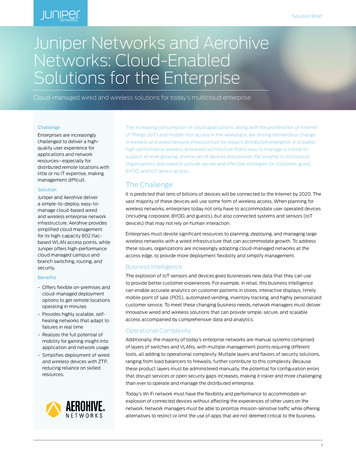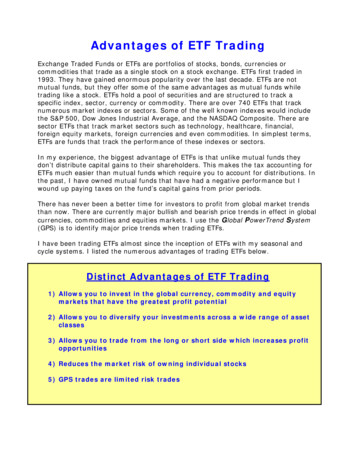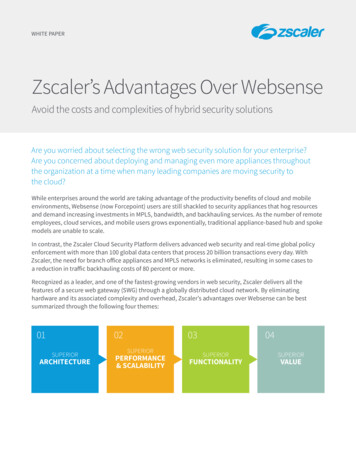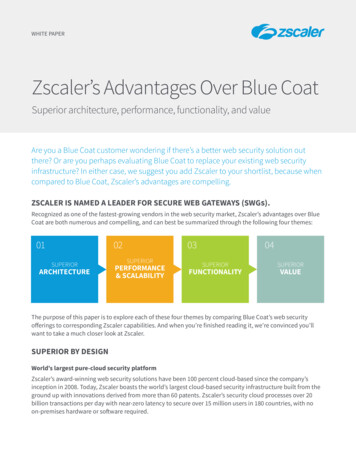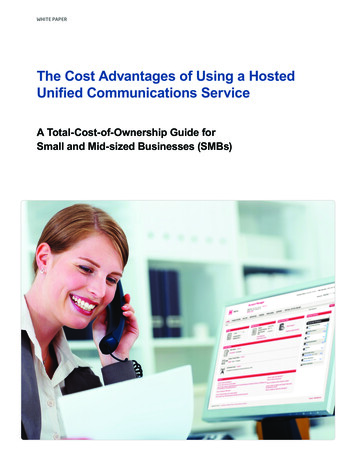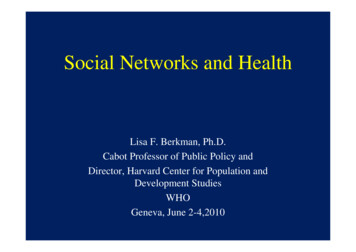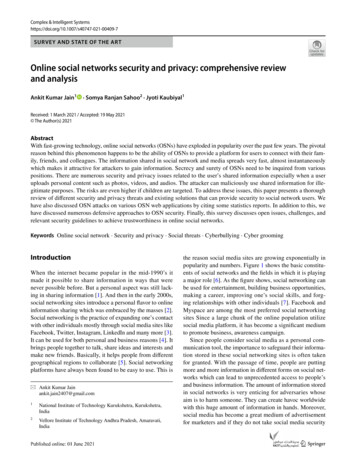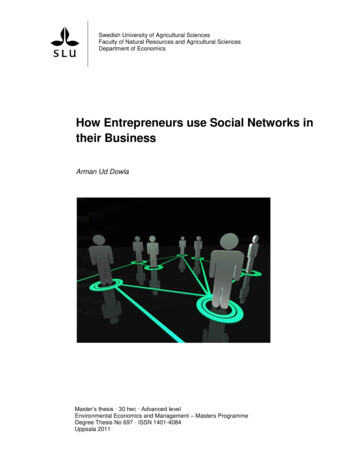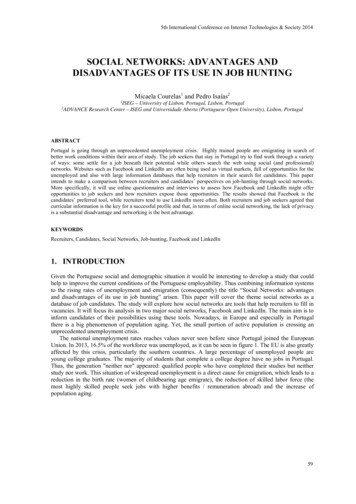
Transcription
5th International Conference on Internet Technologies & Society 2014SOCIAL NETWORKS: ADVANTAGES ANDDISADVANTAGES OF ITS USE IN JOB HUNTINGMicaela Courelas1 and Pedro Isaías22ADVANCE1ISEG – University of Lisbon, Portugal, Lisbon, PortugalResearch Center – ISEG and Universidade Aberta (Portuguese Open University), Lisbon, PortugalABSTRACTPortugal is going through an unprecedented unemployment crisis. Highly trained people are emigrating in search ofbetter work conditions within their area of study. The job seekers that stay in Portugal try to find work through a varietyof ways: some settle for a job beneath their potential while others search the web using social (and professional)networks. Websites such as Facebook and LinkedIn are often being used as virtual markets, full of opportunities for theunemployed and also with large information databases that help recruiters in their search for candidates. This paperintends to make a comparison between recruiters and candidates’ perspectives on job-hunting through social networks.More specifically, it will use online questionnaires and interviews to assess how Facebook and LinkedIn might offeropportunities to job seekers and how recruiters expose those opportunities. The results showed that Facebook is thecandidates’ preferred tool, while recruiters tend to use LinkedIn more often. Both recruiters and job seekers agreed thatcurricular information is the key for a successful profile and that, in terms of online social networking, the lack of privacyis a substantial disadvantage and networking is the best advantage.KEYWORDSRecruiters, Candidates, Social Networks, Job-hunting, Facebook and LinkedIn1. INTRODUCTIONGiven the Portuguese social and demographic situation it would be interesting to develop a study that couldhelp to improve the current conditions of the Portuguese employability. Thus combining information systemsto the rising rates of unemployment and emigration (consequently) the title “Social Networks: advantagesand disadvantages of its use in job hunting” arisen. This paper will cover the theme social networks as adatabase of job candidates. The study will explore how social networks are tools that help recruiters to fill invacancies. It will focus its analysis in two major social networks, Facebook and LinkedIn. The main aim is toinform candidates of their possibilities using these tools. Nowadays, in Europe and especially in Portugalthere is a big phenomenon of population aging. Yet, the small portion of active population is crossing anunprecedented unemployment crisis.The national unemployment rates reaches values never seen before since Portugal joined the EuropeanUnion. In 2013, 16.5% of the workforce was unemployed, as it can be seen in figure 1. The EU is also greatlyaffected by this crisis, particularly the southern countries. A large percentage of unemployed people areyoung college graduates. The majority of students that complete a college degree have no jobs in Portugal.Thus, the generation "neither nor" appeared: qualified people who have completed their studies but neitherstudy nor work. This situation of widespread unemployment is a direct cause for emigration, which leads to areduction in the birth rate (women of childbearing age emigrate), the reduction of skilled labor force (themost highly skilled people seek jobs with higher benefits / remuneration abroad) and the increase ofpopulation aging.59
ISBN: 978-989-8533-29-6 2014Series1; Greece; 27,9European Unemployment Rate - 2013Series1; Portugal; 16,5Series1; Austria; 4,9Figure 1. European Unemployment Rates. (adapted from Eurostat (2013))2. LITERATURE REVIEWThe Oxford Dictionary defines Social Network as “a dedicated website or other application which enablesusers to communicate with each other by posting information, comments, messages, images, etc.” This is avery simplify definition of the term “social network” and this study will focus specifically on online socialnetworks that improve the chances of job candidates finding a job vacancy. Other theorists have a differentapproach on how to define it, for example in the Study of Social Media Communication: Analysis of ScienceCommunication through Social Networking Sites with special reference to Scientists: “Social networking isthe grouping of individuals into specific groups, like small rural communities or a neighborhood subdivision,if you will. Although social networking is possible in person, especially in the workplace, universities, andhigh schools, it is most popular online” (Jothi & Neelamalar, 2010). These authors claim that there is aparticular situation that makes individuals join over the same interest. Boyd and Ellison (2008) state that“web-based services that allow individuals to construct a public or semi-public profile within a boundedsystem, articulate a list of other users with whom they share a connection, and view and traverse their list ofconnections and those made by others within the system. The nature and nomenclature of these connectionsmay vary from site to site” (Boyd & Ellison, 2008). These authors emphasize the personal connections aspectof networking, not focusing as much as the previews ones on personal interest.Overall social networks are considered a public platform, in which different individuals are connected bya relationship. These connections are usually generated by a common element, like a friendship in the realworld or a mutual interest in a specific field. They might be used for leisure like getting in touch with oldfriends, playing online games, or finding out about a particular topic. According to Social Networks BecomeSocial Entertainment research “consumers believe social networks provide a higher value experiencecompared with other forms of entertainment” (Edelman’s, 2010). They might also be used with aprofessional goal like expanding the professional network, finding job opportunities or improving worktopics knowledge. The Queensland Government posted an article on its official website saying that there are5 ways social media can help to improve a business: promote the name of your brand and business; tellcustomers about your goods and services; find out what customers think of your business; attract newcustomers and build stronger relationships with existing customers (Queensland Government, 2010).60
5th International Conference on Internet Technologies & Society 20142.1 Facebook and LinkedInFacebook enables its users to share pictures, videos and personal notes with their online friends. It alsoallows them to create pages and groups divided by topics, which may or may not be public. It is possible forany user to give feedback on any post through “likes” or comments on that same post. Facebook tends to beassociated with leisure and group interaction, but it is more and more a platform used for work and businessrelated purposes.A great amount of people use this network to find a job but “Facebook appears to be a highly underutilized network for recruiting” (Undercover Recruiter, based on 2012 Bullhorn Reach Social RecruitingActivity Report), i.e. recruiters tend to use other tools, like LinkedIn, job posting websites, company sitesetc., to fill in job vacancies. One should wonder if this is one of the mistakes candidates are making that leadsto lack of success in job-hunting. Once candidates are actively using this tool to find a job but recruitersseem to be focusing their efforts on finding a candidate elsewhere, should candidates rethink the use ofFacebook?There is an average of 584 million daily active users on Facebook (Facebook, 2014). Some of them use itsolely as an entertainment tool, others as a work tool (in marketing and social media jobs), others for jobhunting, as mentioned earlier and some for all of the above. These users are risking their security online andoffline by exposing information about themselves. “Risks range from identity theft to online and physicalstalking; from embarrassment to price discrimination and blackmailing” (Gross, & Acquisti, 2005). Throughthis study it will be possible to realize that some people do give misleading (or cautionary) information aboutthemselves. 11% of Facebook users do not use their real name and 49% do not have an identifiable profilepicture. The health care journalist Akshat Rathi considers that Facebook is misleading and that people do nothave enough lucidity to use Facebook. There are two reasons why he makes such statement. The first is thatpeople only post the good parts of their lives and yet they tend to compare their own lives with their virtualfriends unrealistic online lives. The second is that people add some posts that are not meant to be seen byeveryone and the consequences of this fast and wide spread information might be harmful for posters andviewers.This does not mean that Facebook is bad tool or that it should not be used. There are also manyadvantages in using Facebook. Donna Cosmato, a sales management professional, wrote an article in whichshe considered worldwide connectivity the main advantage of social networking. Other advantages accordingto her article are commonality of Interest and Real-Time Information Sharing.Overall there should be caution when using Facebook to find a job. But there are positive aspects as wellas negative ones. The little red suit summarizes it clearly: "College students and young professionals who areusing Facebook for professional networking need to be aware of the amount and type of information they aresharing. That said, many young professionals I know prefer using it for professional networking namelybecause it showcases you as a whole person” (Monhollan, 2008).LinkedIn is the largest platform dedicated solely to professional networking. With over 115 millionregistered users in over 200 countries as of July 2011, LinkedIn represents an exemplar for those scholarsseeking to understand the interplay of employment and social networking” (LinkedIn, 2014). It enables itsusers to “interact with other professionals in their fields, locate potential employers through company pagesand employees, and participate in forums relevant to their professions” (Fawley 2013, p.31).Kasia Mikoluk describes it as “a particularly valuable business tool; over 200 million people aremembers, including hiring managers from many top companies.” (Mikoluk, 2013) - which means that thereare opportunities to contact and connect with this recruiters and possibility find a job - “Your profile isdesigned to function as an online resume, detailing your education, career history (with recommendationsfrom your colleagues), and creative portfolio.” (Mikoluk, 2013)– this enables a dissemination of curriculardata in way that could be done before professional social networks appeared. Stephanie Rosendahl considersthat LinkedIn builds credibility, since “referrals gained through a professional network such as LinkedIn aremore qualified and LinkedIn offers a more efficient way to build your referral base” (Rosendahl, 2013) .Another beneficial aspect of LinkedIn, from her point of view, is the possibility to follow companies and itsemployees.Jessica Key, from the Indianapolis Recorder, believes that there are also negative aspects to LinkedIn.According to her “LinkedIn certainly has made networking easier, but experts say that professionals willalways appreciate personal interactions such as handshakes, written thank-you notes and professional61
ISBN: 978-989-8533-29-6 2014conversation” (Key, 2012). A professional network such as LinkedIn will never replace a real life contact orinterview. Even though it might help get one (interview).Another disadvantage of LinkedIn is the security decrease. Debra L. Bruce wrote an article in which sherefers that “to reap full advantage of LinkedIn, however, the user typically must disclose information such ascurrent and past employers, as well as current contact information” (Bruce, 2010). All this information ismeant to be protected but it is online and there is always the possibility of a cyber-attack so “the user assumesconsiderably more risk of identity theft in the event of a breach in LinkedIn’s security” (Bruce, 2010).2.2 The Recruitment ProcessThe recruitment process includes a variety of stakeholders. Candidates are job seekers. There are two kindsof people who search for a job: “Active job candidates are those currently unemployed, who represent 10percent or less of the total workforce at any given time. Passive job candidates are those who are currentlyemployed and not putting a lot of energy into seeking a new position, but who would consider making a jobchange if the conditions were right.” (Joos, 2008) In this study both of them will be analyzed. Most ofunemployed people in Portugal are young and recently graduated. But there are also candidates of a differentage range (older) and lower level of education/training (INE, 2012).Recruiters are professional specialized in filling job vacancies. They search for the most suited profile tofit a job opening. According to Maringá Management recruitment as a part of human resources managementhas benefited tremendously with the development of the information technologies (Mitter and Orlandini,2005). Recruiters might work in the human resources department of a firm or work in an outsourcing firm ofhuman resources. In this last case usually their main function is to select the most appropriate candidate to fillin a job vacancy.One of the candidates’ methods to look for jobs is the usage of recruitment firms. Recruitment firms areorganizations that have job vacancies for various professional activities. Each of these firms has its owndatabase of contacts, which contains client companies, job seekers and vacancies available. In addition to itsinternal database, in order to find workers to fill their vacancies, its employees (recruiters) use also socialnetworks. There are several recruitment firms in Portugal, most of which are multinational companies. Theydiffer in the type of profile they search. Some look for more educated and high hierarchical level profiles,others look for more simple profiles, simply demanding skills for a blue-collar job.According to Columbia University’s career opportunities department, Social Media is a great tool to finda job. Many websites and blogs consider Facebook and LinkedIn the most useful online instruments in jobhunting. The Bullhorn Reach report states that in 2012 98% of recruiters used LinkedIn and 33% usedFacebook. It also brings to the public knowledge that 48% of recruiters use LinkedIn exclusively.From the candidate’s point of view, social networks are advantageous in terms of dissemination ofpersonal data (Jothi & Neelamar, 2010), professional networking (Queensland Government, 2014),dissemination of curricular data (Monhollan, 2008), entertainment (Edelman Digital, 2010) and socialnetworking (Cosmato, 2013). In contrast, the disadvantages include lack of privacy (Rathi, 2013), decreasedsafety (Gross, & Acquisti, 2005) and lack of confidentiality (Bruce, 2010). When examining the benefits ofsocial networking from the recruiters point of view it is possible to highlight the dissemination of curriculardata (Monhollan, 2008), the dissemination of personal data (Jothi & Neelamar, 2010) and finding Profiles(Mikoluk, 2013). In terms of disadvantages, these include misleading Information (Rathi, 2013) and the lackof personal contact (Key, 2012).3. METHODOLOGYThis exploratory study used two data collection methods. The first was an online survey lodged in Qualtricsplatform and divulged by Facebook pages and groups related to unemployment and job search. The samplewas composed by unemployed individuals. The goal was to determine the importance of social networks injob search and compare it with the perspective of recruiters. The snowball sampling method (Isaías, Pifano &Miranda, 2012) was chosen because it was the fastest way to reach a considerable amount of people in thecircumstances of the study (looking for a job opportunity).62
5th International Conference on Internet Technologies & Society 2014The second method of data collection was an interview conducted with professional recruiters of twodifferent companies (one from a recruitment firm and another recruiter from an information technologycompany), via e-mail, in order to perceive what matters to them in the search process. These interviews wereconducted with recruiters, (that is expanding the number of employees) in order to perceive their experienceswith social networks and what they feel to be the strengths and weaknesses of its use.4. RESULTSThe survey was posted on Facebook groups and pages regarding unemployment (usually accessed by jobseekers). In order to represent the unemployed population a sample of 165 individuals was enquired.Through the survey answers it was possible to acknowledge that social networks are the tool of choice to finda job. 70% of the candidates consider this a good tool to reach a recruiter.It is also possible to confirm that, in fact, Facebook and LinkedIn are the most commonly used socialnetworks, in job search, by candidates. 63% of the respondents use Facebook to search for a job, 43% useLinkedIn and only 17% use other social network. The respondents opinion towards the question of howimportant are social networks in order for a recruiter to decide between two candidates is torn, 45% feel thatit does influence the recruiters opinion and 55% feel that it does not. There is a lot of different data divulgedon social networks. One might assume that while job hunting candidates would post solely curricularinformation, yet that is not accurate. 85% of people post curricular information but they also postphotographs, contact information, events in which they have participated, pictures or texts of their interest.And even their hobbies.Over half of the respondents consider that social and professional networking is a great advantage ofsocial networks. 48% of them consider it a great tool to disseminate curricular data and only 16% thinks ofthis instrument as a way to propagate personal data. On the other hand, 54% of candidates feel likemisleading information is the worst disadvantage of social networks. Privacy decrease is the second mostpointed disadvantage. Safety decrease, confidentiality decrease and lack of personal contact have the samepercentage (39%).The two recruiters’ interviews were held via e-mail in order to understand what recruiters look for whenthey search for online profiles. Both companies chose to stay anonymous, therefore interviewees’ names willnot be revealed. The first recruiter works for a high profile international recruitment company in thetechnology department (HR recruiter). The second recruiter is the co-owner of the I.T. Company. He worksin and the seven years as a HR manager of the company are the only experience he has had as a recruiter (ITrecruiter). He recruits different hierarchical level candidates to integrate into his firm.Recruiters do use social networks to find information about a candidate. Their favourite tool is LinkedInsince it is “the most useful tool to understand the candidate’s career path and purpose” never the lessFacebook allows recruiters to understand people’s profile through their posts. The most relevant informationin a social network profile are the professional accomplishments although comments and photos publishedmight show a side of the candidate that makes the recruiter choose someone else.There is a common understanding that LinkedIn is a much more restricted and professional network thenother sites. Recruiters expect to find the profiles they are looking for there. Social networks should not beconsidered a fighting arena. Recruiters look for candidates that fit the job needs but they do not decide whichone will get the opening until there is an interview. Never the less a profile with negative information mightexclude the candidate from the possi
utilized network for recruiting” (Undercover Recruiter, based on 2012 Bullhorn Reach Social Recruiting Activity Report), i.e. recruiters tend to use oth
